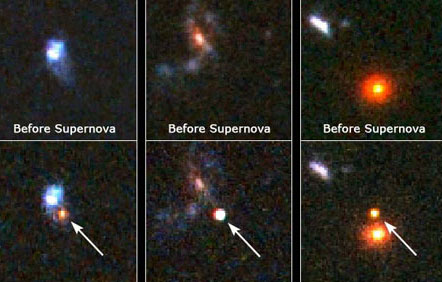| 哈勃望远镜太空15年的10大发现(图) |
| http://www.sina.com.cn 2005/04/28 20:44 国际在线 |
 Hubble's Top Ten Discoveries 在太空服役的15年中,哈勃望远镜帮助测定了宇宙年龄;证实了星系中央存在黑洞;发现了年轻恒星周围孕育行星的尘埃盘;拍下了彗星撞击木星的照片;帮助确认了宇宙中存在暗能量。 1、这是一组哈勃望远镜拍摄下来的,遥远的超新星以及这些巨大的星体发生死亡爆炸的景象。上面一组照片显示出爆炸发生之前的各自的区域,下面一组显示的是爆炸的结果。 美国国家航空航天局(NASA)表示,哈勃望远镜在对暗能量(dark energy)的研究工作中扮演了至关重要的角色。暗能量是一种神秘形态的力,起到宇宙气体“踏板”的作用,加速了宇宙膨胀的速度。暗能量推挤各个星系,使它们抗拒重力的拘束,以不断增长的速度彼此远离。哈勃望远镜关于超新星的资料帮助研究者揭示出,这种神秘力量在宇宙中是持续存在的。 A collection of Hubble Space Telescope images shows distant supernovas, the death explosions of massive stars. The top photos show each region before the explosion. The bottom row shows the explosions' aftermaths According to NASA, "Hubble played a key role in discovering that a mysterious form of energy called dark energy is acting like a cosmic gas pedal, accelerating the universe's expansion rate. Dark energy shoves galaxies away from each other at ever-increasing speeds and works in opposition to gravity." Hubble's observations of supernovas helped reveal that the mysterious energy is a constant presence in the universe. 2、美国国家航空航天局表示,哈勃的主要任务之一就是帮助天文学家测定宇宙的准确年龄。现在,它已经顺利地完成了任务,帮助天文学家将宇宙的年龄精确到130亿至140亿年之间。天文学家用哈勃观测到仙女星座和其它星群中的造父变星(如图),以确定宇宙的膨胀速度和宇宙的年龄。 According to NASA, "One of Hubble's key duties was to help astronomers determine a precise age for the universe. The telescope helped astronomers accomplish that goal, narrowing the universe's age to 13 to 14 billion years old, an accuracy of about 10 percent. Astronomers made observations of Cepheid variable stars [pictured above]—pulsating stars used to measure vast distances—in the Virgo and other clusters to establish the expansion rate and the universe's age." 3、美国国家航空航天局表示,哈勃给天文学家提供了一个“剪贴本”,里面全是一些有关于早期宇宙的快照。其中包括在探索纵深宇宙的过程中,一系列独一无二的资料图片:如“哈勃深空”(Hubble Deep Fields);“大天文台宇宙起源深空巡天”(Great Observatories Origins Deep Survey ,GOODS)和哈勃超深空(Hubble Ultra Deep Field, HUDF,如图示),这些观测资料向人们提供了以可见光可观测到的宇宙最深处的景象。 According to NASA, "Hubble provided astronomers with a 'scrapbook' full of snapshots of the early universe ...[including] pictures of the 'deep' universe in a series of unique observations: the Hubble Deep Fields, the Great Observatories Origins Deep Survey, and the Hubble Ultra Deep Field [pictured above]. The observations provided the deepest views of the cosmos in visible, ultraviolet, and near-infrared light." 4、美国国家航空航天局表示,天文学家使用地面望远镜搜寻在太阳系之外的行星,发现了上百个不同的天体。但是,天文学家仍需要一双敏锐的眼睛——哈勃来首次完成对这太阳系之外的一颗行星大气层化学构成的直接测量。哈勃望远镜在一颗木星般大小的行星的大气中,发现了钠、氢、碳以及氧元素。这个独一无二的观测结果证明,哈勃和其它望远镜可以从其它一些天体的大气中进行化学构成的采样工作。 According to NASA, "Astronomers using ground-based telescopes to hunt for planets outside our solar system, dubbed extrasolar planets, have nabbed more than a hundred alien worlds. But they needed the keen 'eye' of Hubble to make the first direct measurement of the chemical makeup of an extrasolar planet's atmosphere. The telescope detected the elements sodium, hydrogen, carbon, and oxygen in the atmosphere of a Jupiter-size planet. The unique observation demonstrates that Hubble and other telescopes can sample the chemical makeup of the atmospheres of alien worlds." 5、哈勃望远镜拍摄下来的图象:M87一个巨大的椭圆星系。椭圆星系并不具有大多数星系具有的扁圆或是螺旋型的形状。 美国国家航空航天局表示,大多数星系的中心都具有一个巨大的东西,可以吞噬想接近它的一切东西,这是一个沉睡的怪物,哈勃的观测资料证实了这一点,这就是黑洞。 A Hubble Space Telescope image—taken using only light that would be visible to the naked eye— shows M87 [lower right] a giant elliptical galaxy. Elliptical galaxies do not take on the flat-disk or spiral shapes that most galaxies do. According to NASA, "The hubs of most galaxies have a mammoth resident that loves to gobble up anything that wanders near it. This sleeping monster, Hubble observations confirmed, is a black hole with a mass millions to billions times that of our sun." 6、哈勃望远镜捕捉到的这张照片显示的是1999年1月23日伽马射线爆炸的景象。这是当时人们纪录过的最大规模的一次伽马射线爆炸。 美国国家航空航天局表示,自从宇宙大爆炸(创世大爆炸)以来,伽马射线大爆炸可能是宇宙中力量最为强大的爆炸了。哈勃拍摄到的图象显示,这些放射线的短暂闪光来自于遥远的星系,这些星系以非常快的速度形成众多恒星。哈勃望远镜在确定了寄主星系之后,还确定了这些爆炸的来源——一些巨大星体的瓦解。 A Hubble Space Telescope image—taken using only light that would be visible to the naked eye— shows M87 [lower right] a giant elliptical galaxy. Elliptical galaxies do not take on the flat-disk or spiral shapes that most galaxies do. According to NASA, "The hubs of most galaxies have a mammoth resident that loves to gobble up anything that wanders near it. This sleeping monster, Hubble observations confirmed, is a black hole with a mass millions to billions times that of our sun." 7、一组哈勃拍摄到的恒星状球体(类星体)的宿主星系的图片。 自从恒星状球体在1963年被首次发现,天文学家就开始试图弄清这些位于宇宙外部区域的类星体是如何持续产生强大、耀眼的光亮的。这些恒星状球体并不比我们的太阳系大,但是它却比拥有数十亿星体的星系还要亮很多。天文学家使用哈勃望远镜追踪到这些恒星状球体的“家”(宿主星系),并且证明它们位于这些星系的中心区域。 A collection of Hubble space telescope images shows galaxies that host quasars. According to NASA, ever since quasars were first discovered in 1963 "astronomers have been trying to crack the mystery of how these compact dynamos of light and other radiation, which lie at the outer reaches of the universe, produce so much energy. Quasars are no larger than our solar system but outshine galaxies of hundreds of billions of stars. These light beacons have left trails of evidence and plenty of clues, but scientists have only just begun to understand their behavior. Astronomers using Hubble tracked down the 'homes' of quasars, proving that these dynamos reside in the centers of galaxies." 8、这是哈勃望远镜拍摄到的猎户星云中的原行星盘(proplyds,protoplanetary disks)。 星云,失去光泽的大气和尘埃盘,似乎是新行星系统的诞生地。哈勃拍摄到的资料向人们提供了可以看到的证明,它显示,烤盘形状的尘埃盘围绕着年轻恒星的现象是很平常的。 A Hubble Space Telescope image shows "proplyds," or protoplanetary disks, in the Orion Nebula. According to NASA, nebulae, flattened disks of gas and dust, "are the likely birthplaces of new planetary systems. Hubble provided visual proof that pancake-shaped dust disks around young stars are common, suggesting that the building blocks for planet formation are in place." 9、哈勃望远镜拍摄到的这个画面上,一些清晰可见的黑色疤痕向人们揭示出,1994年7月份一颗命名为苏梅克·列维9号的彗星断裂成21个碎块撞击木星的情景,撞击产生的蘑菇形的火球在冲击到了木星的上空。 Black scars reveal the aftermath of Jupiter's impact with nearly two dozen chunks from comet Shoemaker-Levy 9 in 1994. The impacts "sent towering mushroom-shaped fireballs of hot gas into the Jovian sky," according to NASA. 10、在跳跃的颜色中烁烁发光的行星状星云(就像上面这颗)向人们描绘出垂死恒星的最后色彩。行星状星云实际上是一些即将消亡的恒星抛射出的气体外壳,在学术上与行星并没有什么关系。哈勃望远镜告诉人们,行星状星云就像雪花一样,没有任何两个是一样的。 Glowing in vibrant colors, planetary nebulae, such as this one, represent the death rattles of dying stars. These nebulae, which are not technically related to planets, are gas clouds forced outward by a dying star. According to NASA, "Hubble's keen 'eye' disclosed that planetary nebulas are like snowflakes: no two are like." (文/王高山) |
| 【评论】【英语论坛】【大 中 小】【打印】【下载点点通】【多种方式看新闻】【收藏】【关闭】 |